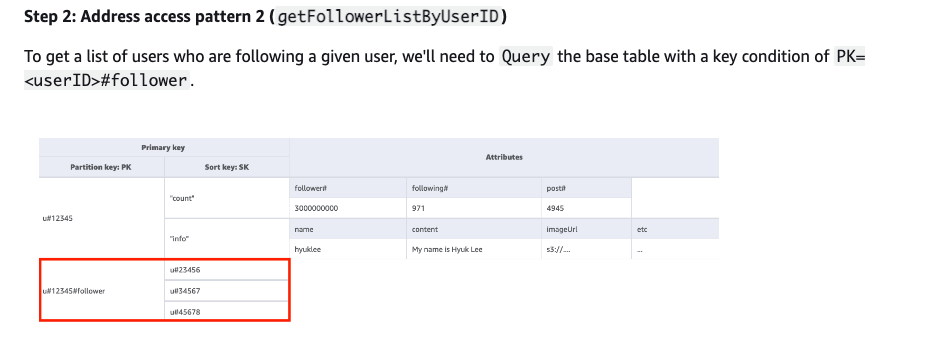1 Respuesta
- Más nuevo
- Más votos
- Más comentarios
1
To avoid data duplication, you first Query the list of users. From the list returned, you then do a BatchGetItem which can return you up to 100 followers profile information per request. Then you lazily load this, so get 100 and populate your dashboard. If the user scrolls past 80 users, fetch the next 100 in the list and continue paging as much as the user scrolls.
Contenido relevante
 OFICIAL DE AWSActualizada hace 2 años
OFICIAL DE AWSActualizada hace 2 años OFICIAL DE AWSActualizada hace 3 años
OFICIAL DE AWSActualizada hace 3 años OFICIAL DE AWSActualizada hace un año
OFICIAL DE AWSActualizada hace un año
 ..
So according to the example in the red mark the PK is userId i.e u#12345#following and the user who are following is in the SK. So if you want to getFollowerListByUserID so to get a list of users who are following a given user, we'll need to Query the base table with a key condition of PK=<userID>#follower. By this example we can get list of all users id who are following u#12345. but on the real world scenario we not only want the id we also want data also . like follower name, image, profile data like all these thing to show on frontend side. but on this example there is no data attached of followers. if i also attached the data on the follower items then there would be data duplication around every item user is following some one. and if user update his data he also need to update data on every follower item.
..
So according to the example in the red mark the PK is userId i.e u#12345#following and the user who are following is in the SK. So if you want to getFollowerListByUserID so to get a list of users who are following a given user, we'll need to Query the base table with a key condition of PK=<userID>#follower. By this example we can get list of all users id who are following u#12345. but on the real world scenario we not only want the id we also want data also . like follower name, image, profile data like all these thing to show on frontend side. but on this example there is no data attached of followers. if i also attached the data on the follower items then there would be data duplication around every item user is following some one. and if user update his data he also need to update data on every follower item.
ok lets just say if a user has 5000 followers . then i am going fetch all list of followeres data by calling batchGetItem 50 time am i right?
Correct, but you only call the batchget when needed. You wouldn't load all 5000 items in one go.